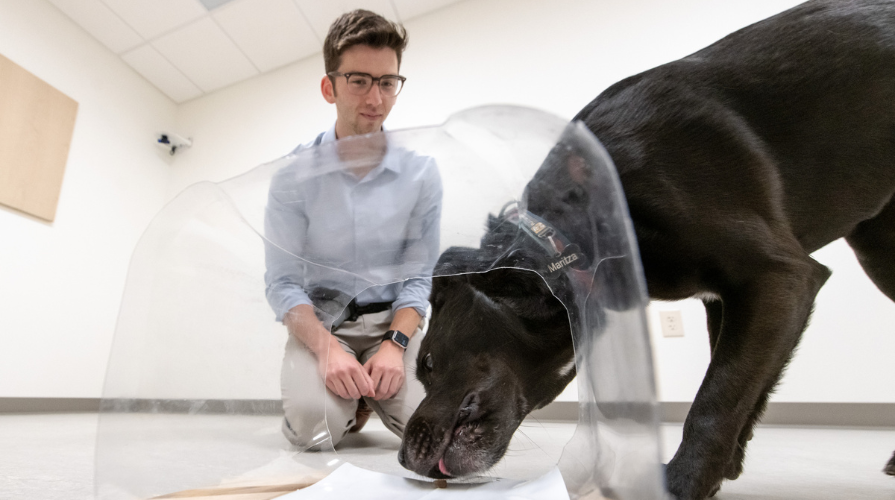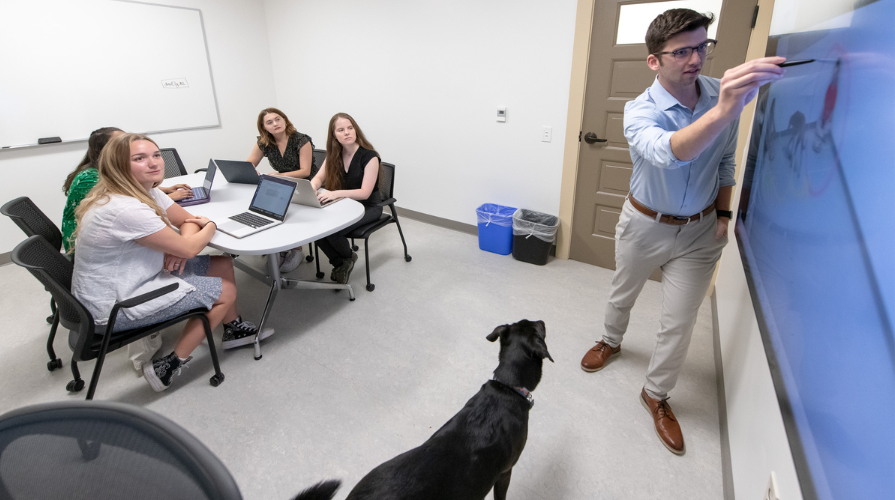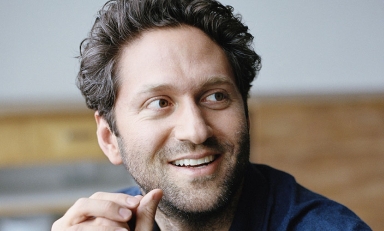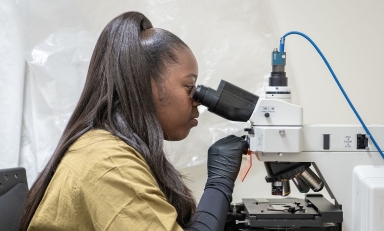
Assistant Professor of Psychology Zachary Silver has launched a canine cognition laboratory to study how dogs make sense of the complicated human social world in which they live—and he’s inviting the community to participate.
Working with dogs from both the Occidental and greater Los Angeles communities, Silver and his students will focus on how dogs interpret human emotional displays and use those interpretations to guide their own behaviors toward people and in new situations.
“We hear stories all the time about people whose dogs can tell when they’re happy, when they’re sad, or when they need comfort, but we don’t have a lot of scientific information about how that works,” Silver says. “We want to understand: How do dogs make these kinds of emotional assessments about humans?”
Dogs occupy a unique position within human society. Often kept as pets, they’re also used as working animals for activities as varied as guiding, herding, guarding, hunting, policing, and medical service. Some dogs are trained in showmanship, competing regularly in agility trials or pageants like the Westminster Dog Show. No other domesticated animal performs quite so many functions in service of human needs.
We hear stories all the time about people whose dogs can tell when they’re happy, when they’re sad, or when they need comfort, but we don’t have a lot of scientific information about how that works.”
During the multi-generational domestication process, humans shaped dogs’ minds as well as their physical appearance, training them to become incrementally more attuned to subtleties of human communications and behaviors. As a result, the modern domestic canine displays human-like patterns of thinking and reasoning in social situations.
Silver and his students are testing this social and emotional intelligence through a series of puzzles and games. To earn snack rewards, participating dogs must demonstrate their ability to identify positive social and emotional traits in potential human social partners. The puzzles ask dogs to choose between “kind” and “mean,” “skilled” and “unskilled,” “happy” and “sad,” and “strong” and “weak” experimenters, based on the experimenters’ behaviors. For instance, a “mean” experimenter might move a snack frustratingly out of reach.
“We’ve found that dogs show strong preferences for experimenters who display positive behaviors,” Silver says, explaining that dogs with agility training have appeared particularly able to discern between the “nice” and “mean” categories. “This suggests that dogs make inferences about the social interactions they observe and how those might relate to how unknown humans may interact with them in the future.”

Silver has long been interested in understanding the complex social relationship between humans and canines. Observing the ways in which his childhood pet dogs interacted with people, he says, “was really my first moment of scientific curiosity, long before I knew what psychology or canine cognition was.”
At Illinois Wesleyan University, where he double majored in psychology and music, Silver explored various psychology research laboratories on campus, eventually working in an animal cognition lab that worked with both dogs and non-human primates—“the perfect convergence of the scientific interest I had before starting my psychology degree and what I was studying as a psychology major,” he says.
That experience led him to the canine cognition lab at Yale University, where he developed his own research interests while earning his PhD. He’s hoping to further that research at Oxy, examining canine self-control and how the evolutionary underpinnings of dogs’ social cognition can shed light on humans’ social cognitive development. Ultimately, Silver believes his studies could help average dog owners understand how to more immediately and comfortably assimilate a dog into a new home environment and strengthen the bond between themselves and their pets.
The more we understand about how dogs’ minds work, the better we can structure our interactions with them, build better relationships with them, and become better dog owners.”
“This lab is approaching an evolutionary question and a practical, applied question concurrently,” Silver says. “By comparing canine and human cognitive development, we can pinpoint what elements of our cognition are unique and what might be primed by our social environments. And the more we understand about how dogs’ minds work, the better we can structure our interactions with them, build better relationships with them, and become better dog owners.”
Silver’s doctoral laboratory experience also provided him with his first opportunity to mentor undergraduates and train them to become skilled researchers—training he now provides in his Oxy lab. In addition to developing a scientific skillset through designing experiments and analyzing data, Silver’s student researchers will hone their interpersonal abilities as they interact with community participants, communicate their findings concisely and effectively, and explain the work they do to fellow researchers.
Regardless of whether his students plan to apply these skills to their own future graduate research, Silver believes this type of mentorship is valuable for its interdisciplinary applicability.
“I want to make sure that this training prepares students for anything they want to do after working in my lab,” he says, noting that previous mentees have pursued careers in medicine and the law as well as psychology. “Offering that kind of multifaceted experience is really important to me, being at a liberal arts college like Oxy.”
How to Get Involved
The lab is open to participants from the Los Angeles area who meet the following criteria: Dogs must be older than 16 weeks, current on their vaccines, and—most importantly—not aggressive toward humans. For more information, visit the Oxy Canine Cognition Laboratory sign-up form.



